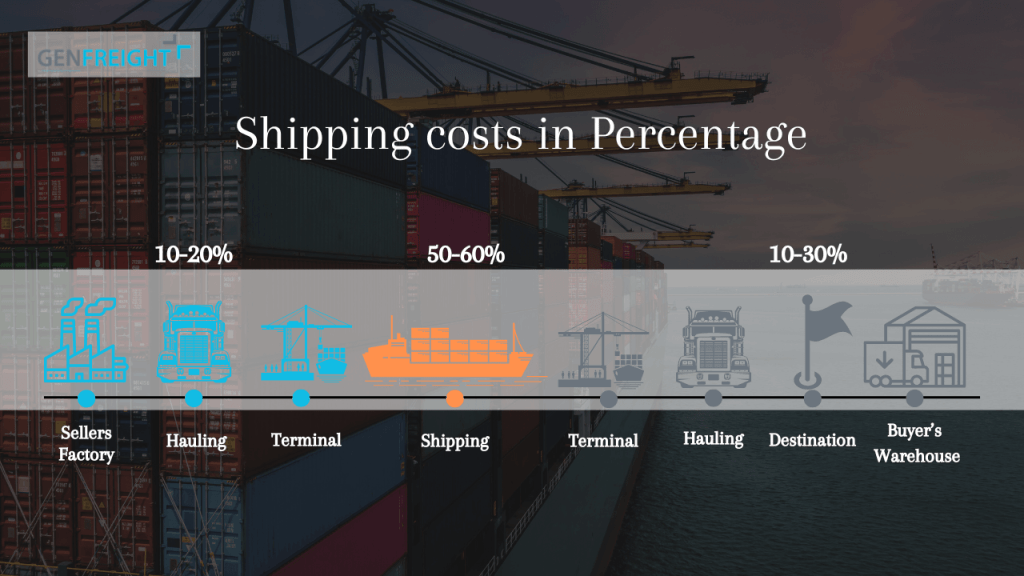In today’s interconnected world, businesses are no longer limited by local or national borders. Above all, they can reach a global audience, but this also presents challenges, like shipping products across vast distances. Freight forwarders play a vital role in this scenario. Nevertheless, with numerous options available, finding the best partner to optimise your shipping costs can be tricky. This guide explores the complexities of cost-effective freight forwarding, offering insights and strategies to optimise your shipping processes.

What is Shipping Optimisation?
Shipping optimisation refers to the strategies and practices that businesses use to reduce their freight costs. Importantly, this is done without compromising on service or delivery times. It involves a holistic approach, considering aspects from packaging and consolidation to carrier selection and negotiation.
What Shipping Costs Are Included in Freight?
Freight costs generally encompass various charges associated with moving goods from origin to destination. These typically include:
-
- Ocean freight: The cost of transporting goods by sea.
- Air freight: The cost of transporting goods by air.
- Inland freight: The cost of transporting goods from the port of arrival or airport to the final destination within the importing country.
- Terminal handling charges: Fees associated with loading and unloading cargo at ports and terminals.
- Customs clearance charges: Fees for processing goods through customs.
- Fuel surcharges: Additional charges imposed by carriers to offset fluctuations in fuel prices.
- Documentation fees: Costs associated with preparing shipping documents.
The Difference Between Freight and Forwarding Charges
Freight charges refer to the actual cost of transporting goods. Conversely, forwarding charges are the fees collected by freight forwarders for their services. These services generally include arranging transportation, booking cargo space, negotiating rates with carriers, preparing shipping documents, and tracking shipments.
How Can Shipping Costs Be Optimised?
Several strategies can help you significantly optimise your transport costs:
- Packaging optimisation: Firstly, minimise packaging size and weight while ensuring product protection.
- Consolidation: Also combine multiple smaller shipments into a single larger shipment to benefit from economies of scale.
- Planning ahead: Give your freight forwarder ample notice to secure better rates, so you can avoid rush shipping fees.
- Negotiating with carriers: Moreover, leverage your freight forwarder’s relationships with carriers to negotiate competitive rates.
- Considering alternative modes of transport: Depending on your needs, air freight, sea freight, or rail may offer cost savings compared to traditional methods.
- Using Incoterms: Additionally, these internationally recognised terms define the responsibilities of buyers and sellers in international trade transactions, helping to avoid confusion about shipping costs and risks.
- Regularly reviewing shipping contracts: Lastly, ensure you’re getting the best possible rates and terms by periodically reviewing your contracts with carriers.
How to Choose the Right Freight Forwarder
A reliable freight forwarder can significantly impact your import success. Here are key factors to consider when making your choice:
- Experience and expertise: The most important is to look for a forwarder with experience in your industry. Also the freight forwarder has to be familiar with the types of goods you import.
- Network of carriers: A broad carrier network allows for comparing rates and thereby finding the most suitable option for your needs.
- Reputation: Check online reviews and testimonials to gauge the forwarder’s track record for on-time deliveries and excellent customer service.
- Technology: Opt for a forwarder that utilises technology to streamline the shipping process, such as online shipment tracking and automated notifications.
- Price: While cost is important, don’t solely focus on the cheapest option. A reliable and experienced forwarder can save you money in the long run by avoiding delays and mistakes.
GenFreight Global Logistics Pty Ltd: Your Trusted Partner in Import and Freight Forwarding
GenFreight Global Logistics Pty Ltd is a leader in custom clearance and freight forwarding services in Australia. With extensive experience and a global network of partners, we are well-equipped to meet your business needs. Consequently, we offer a comprehensive suite of solutions to help businesses optimise their shipping costs and ensure a smooth import process. Contact us today to discuss your specific needs and receive a free quote.
Key Takeaways
1. Leverage Contractual Agreements
Steady Lane Volume Contracts:
Firstly, negotiate contracts with carriers for regular freight flow on specific routes. This loyalty benefits both parties, often leading to discounted rates and improved service.
2. Optimise Your Pick-up and Delivery Schedule

Off-Peak Day Shipping:
Secondly, consider shipping on weekdays other than Fridays when consumer demand is high. Mondays can also be slower for some industries.
Night-time Pick-ups:
Additionally, offer later pick-up times to allow carriers to fill empty backhauls on longer routes, reducing their overall costs and potentially yours.
3. Minimise Pallet Space for LTL Shipments (Less than truckload)
Optimise Cube Utilisation:
Thirdly, strategically pack your products to maximise the number of items that fit on a pallet. As a result this reduce the number of pallets needed for your shipment.
4. Embrace Collaboration
Retail Consolidation:
Additionally, partner with nearby businesses shipping to the same retailers to combine LTL shipments into a single TL shipment. As a result it will lower costs for everyone involved.
Vendor Managed Inventory (VMI):
Also collaborate with retailers to implement VMI, where they only pay for your products when they sell them. This reduces your storage and transportation costs associated with holding excess inventory.
5. Invest in Sustainable Packaging
Right-sizing Packaging:
Moreover, use appropriately sized boxes that minimise empty space while ensuring product protection. This reduces both packaging costs and dimensional weight, which some carriers factor into pricing.
Eco-friendly Materials:
Lastly, consider using recyclable or biodegradable packaging materials to potentially qualify for discounts from environmentally conscious carriers.

The Role of Technology in Shipping Costs Optimisation
Undoubtedly, echnology plays a crucial role in modern freight forwarding and cost optimisation. Here’s how:
- Transportation Management Systems (TMS): These software solutions automate tasks like shipment booking, tracking, and documentation, streamlining processes and reducing errors.
- Real-time Tracking: Gain instant visibility into shipment location and status, allowing for proactive problem-solving and improved decision-making.
- Data Analytics: Leverage data to identify trends and opportunities for further cost savings. Also analyse past shipping data to identify areas for improvement and negotiate better rates with carriers.
In conclusion, optimising your shipping costs is an ongoing process that requires a strategic approach. By implementing the strategies outlined above and partnering with a reliable expert freight forwarder, you can significantly reduce your import expenses and gain a competitive edge in the global marketplace. What’s more, remember that effective communication, continuous improvement, and a data-driven approach are essential for success in today’s dynamic import landscape.
We hope this comprehensive guide empowers you to navigate the world of freight forwarding so as to optimise your import costs. If you have any questions or require assistance with your import needs, don’t hesitate to contact GenFreight Global Logistics. Our team of experts is here to help you achieve a seamless and cost-effective import experience.
